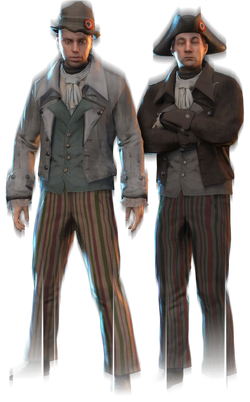
The sans-culottes (meaning "without culottes", or breeches) referred to the lower classes of 18th century France, many of whom became violent partisans when the French Revolution broke out.
History
The sans-culottes took their name due to the fact that they belonged to the lower classes, who wore pantalons, long trousers, rather than the culottes, silk knee-breeches, worn by the upper classes. Comprising elements from the Third Estate, including merchants and peasants, the finances of France relied upon them, even though many of them were poor.[1]
Although the term sans-culottes initially referred to the common men who committed violence in the name of the revolution, it came to refer to all those opposed to the aristocracy and the counter-revolutionaries.[2] They were among the most ardent supporters of the revolution, holding significant political influence.[1]
Led by radicals such as Jean-Paul Marat, Jacques Roux, Jacques Hébert and Jean Lessard, the sans-culottes were present at many of the important events of the revolution, including the Storming of the Bastille and the Women's March on Versailles. They sang revolutionary songs such La Carmagnole and Ça Ira and often wore Phrygian caps, which became their symbol in 1792.[2]
The sans-culottes would also harass aristocrats and their associates, Jean-Jacques Calvert,[3] Marie Tussaud and Désirée Clary among them.[2]
After the downfall of Maximilien de Robespierre and the Jacobins in the Thermidorian Reaction of 1794 and the establishment of the conservative Directory regime, most of the sans-culottes were killed or otherwise supressed by the Muscadins, groups of middle-class street fighters who feared a return to the Jacobins' radical Reign of Terror.[4]
Gallery
References
- ↑ 1.0 1.1 Project Widow
- ↑ 2.0 2.1 2.2 Assassin's Creed: Unity
- ↑ Assassin's Creed: Unity novel
- ↑ Ubisoft (12 November, 2014). Revolution Reaction – Fops on the march!. Ubisoft. Archived from the original on 22 September 2024.
